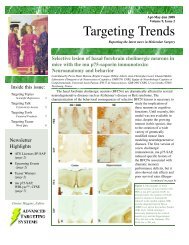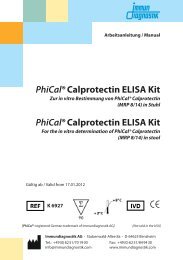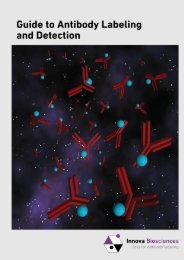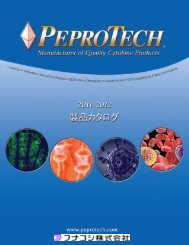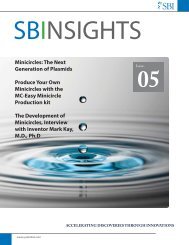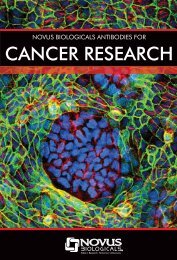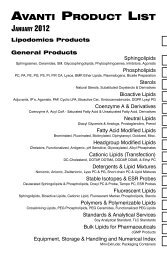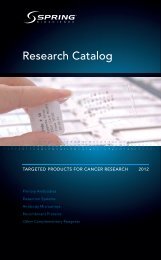T7 RNA Polymerase Expression System for Bacillus megaterium
T7 RNA Polymerase Expression System for Bacillus megaterium
T7 RNA Polymerase Expression System for Bacillus megaterium
You also want an ePaper? Increase the reach of your titles
YUMPU automatically turns print PDFs into web optimized ePapers that Google loves.
© MoBiTec GmbH, 2012 Page 9<br />
4.4. Protein production<br />
I. Test protein production<br />
1. Grow the recombinant B. <strong>megaterium</strong> cells in LB medium including antibiotic (here:<br />
tet/cm) in baffled shaking flasks to an optical density at 578 nm (OD578nm) of 0.3 - 0.4<br />
at 37 °C and strong shaking (250 rpm)<br />
2. Take a sample as control be<strong>for</strong>e induction<br />
3. Induce the xylose inducible promoter by the addition of 0.5 % of (D)-xylose<br />
4. Incubate at 37 °C and strong shaking (250 rpm)<br />
5. Withdraw samples every 30 to 60 minutes until an OD578nm of around 4 to 5<br />
(depending on the growth medium) is reached (now, cells have entered the stationary<br />
phase). Take samples <strong>for</strong> OD578nm-measurement and protein analysis. For<br />
extracellular protein analysis take 2 ml of cell culture. For intracellular protein analysis<br />
take 3 OD equivalents.<br />
6. Centrifuge each sample to harvest cells and cell free supernatant<br />
7. For extracellular protein analysis remove supernatant and store at 4 °C, <strong>for</strong><br />
intracellular protein analysis completely remove supernatant and store cells at -20 °C.<br />
II. Analysis of intracellular proteins<br />
1. Resuspend cells in 30 �l of lysis buffer<br />
2. Incubate <strong>for</strong> 30 min at 37 °C and 1,000 rpm. Vortexing every 10 minutes increases<br />
cell lysis<br />
3. Centrifuge <strong>for</strong> 30 min at 4°C and 13,000 rpm to separate the insoluble fraction (pellet)<br />
from the soluble fraction (supernatant)<br />
4. Mix 27 µl of supernatant (containing soluble proteins) with 13 µl of SDS sample buffer<br />
5. Completely remove the supernatant. Resuspend the pelleted fraction in 30 ml of 8 %<br />
urea (w/v). Centrifuge <strong>for</strong> 30 min at 4°C and 13,000 rpm<br />
6. Mix 27 µl of the supernatant (containing insoluble proteins) with 13 µl of SDS sample<br />
buffer<br />
7. Heat each sample <strong>for</strong> 5 min at 95 °C<br />
8. Load 7.5 µl of each sample (containing cells of 0.5 OD) onto an SDS-page gel<br />
III. Ammonium sulfate precipitation of proteins in the cell-free supernatant<br />
1. Add 600 mg of pestled ammonium sulfate to 1.5 ml of cell free supernatant and<br />
incubate <strong>for</strong> two hours at 4 °C and shaking<br />
2. Centrifuge at 13,000 rpm and 4 °C <strong>for</strong> 30 minutes<br />
3. Completely remove the supernatant, centrifuge again <strong>for</strong> 1 min and make sure the<br />
protein pellet is dry<br />
4. Add 10 µl of 8 M urea (in 50 mM Tris-HCl, pH 7.5) and 5 µl SDS sample buffer to<br />
solve the proteins again<br />
5. Spin shortly at 13,000 rpm, head to 99 % <strong>for</strong> 5 minutes and load onto a SDS<br />
polyacrylamide gel <strong>for</strong> analysis<br />
6. Determine enzymatic activities with the appropriate assays (not included in the kit)<br />
7. Per<strong>for</strong>m Western blot using appropriate antibodies (not included in the kit)<br />
MoBiTec GmbH, Germany � Phone: +49 551 70722 0 � Fax: +49 551 70722 22 � E-Mail: info@mobitec.com � www.mobitec.com



